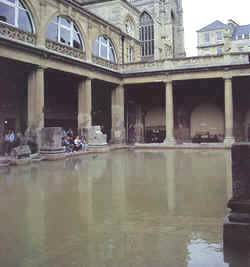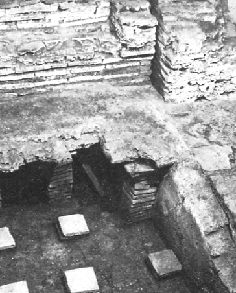Roman baths were part of the day-to-day life in Ancient Rome. Bath in Somerset, contains one of the best examples of a Roman bath complex in Europe. There are two good examples at Pompeii.
|
The baths at Bath |
Roman houses had water supplied via lead pipes. However, these pipes were taxed according to their size, so many houses had just a basic supply and could not hope to rival a bath complex. Therefore for personal hygiene, people went to the local baths. However, the local bath complex was also a gathering point and served a very useful community and social function. Here people could relax, keep clean and keep up with the latest news.
Taking a bath was not a simple chore. There was not just one bath to use in a large complex such as the one at Bath. A visitor could use a cold bath (the frigidarium), a warm bath (the tepidarium) and a hot bath (the caldarium). A visitor would spend some of his time in each one before leaving. A large complex would also contain an exercise area (the palaestra), a swimming pool and a gymnasium. One of the public baths at Pompeii contains two tepidariums and caldariums along with a plunge pool and a large exercise area.
The building of a bath complex required excellent engineering skills. Baths required a way of heating up water. This was done by using a furnace and the hypocaust system carried the heat around the complex.
|
Remains of a hypocaust |
Water had to be constantly supplied. In Rome this was done using 640 kilometres of aqueducts – a superb engineering feat. The baths themselves could be huge. A complex built by the emperor Diocletian was the size of a football pitch. Those who built them wanted to make a statement – so that many baths contained mosaics and massive marble columns. The larger baths contained statues to the gods and professionals were on hand to help take the strain out of having a bath. Masseurs would massage visitors and then rub scented olive oil into their skin.
It was very cheap to use a Roman bath. A visitor, after paying his entrance fee, would strip naked and hand his clothes to an attendant. He could then do some exercising to work up a sweat before moving into the tepidarium which would prepare him for the caldarium which was more or less like a modern sauna. The idea, as with a sauna, was for the sweat to get rid of the body’s dirt. After this a slave would rub olive oil into the visitor’s skin and then scrap it off with a strigil. The more luxurious establishments would have professional masseurs to do this. After this, the visitor would return to the tepidarium and then to frigidarium to cool down. Finally, he could use the main pool for a swim or to generally socialise. Bathing was very important to the Ancient Romans as it served many functions.
| “We quickly undressed, went into the hot baths and after working up a sweat, passed on to the cold bath. There we found Trimalchio again. His skin was glistening all over with perfumed oil. He was being rubbed down, not with ordinary linen, but with cloths of the purest and softest wool. he was then wrapped in a blazing scarlet robe, hoisted into a litter, and trundled off.”Petronius. |
However, not everyone was overjoyed by them:
| “I live over a public bath-house. Just imagine every kind of annoying noise! The sturdy gentleman does his exercise with lead weights; when he is working hard(or pretending to) I can hear him grunt; when he breathes out, I can hear him panting in high pitched tones. Or I might notice some lazy fellow, content with a cheap rub-down, and hear the blows of the hand slapping his shoulders. The sound varies, depending on whether the massager hits with a flat or hollow hand.To all of this, you can add the arrest of the occasional pickpocket; there’s also the racket made by the man who loves to hear his own voice in the bath or the chap who dives in with a lot of noise and splashing.”Seneca in AD 50 |
As the Romans advanced west in England, building the Fosse Way as they went, they crossed the River Avon. Near here they found a hot water spring. It brought over one million litres of hot water to the surface every day at a temperature of about 48 degrees centigrade. They built a reservoir to control the water flow, baths and a temple. A town, Bath, quickly grew around this complex. Many Romans viewed the springs as sacred and threw valuable items into the springs to please the gods. An altar was also built at Bath so that priests could sacrifice animals to the gods. The waters at Bath gained a reputation as being able to cure all ills. As a result, may travelled to Bath from all over the Roman Empire to take to the waters there.

